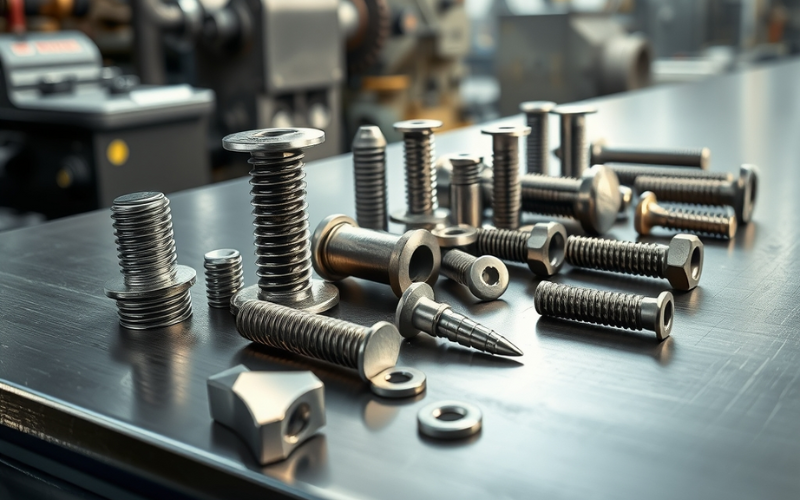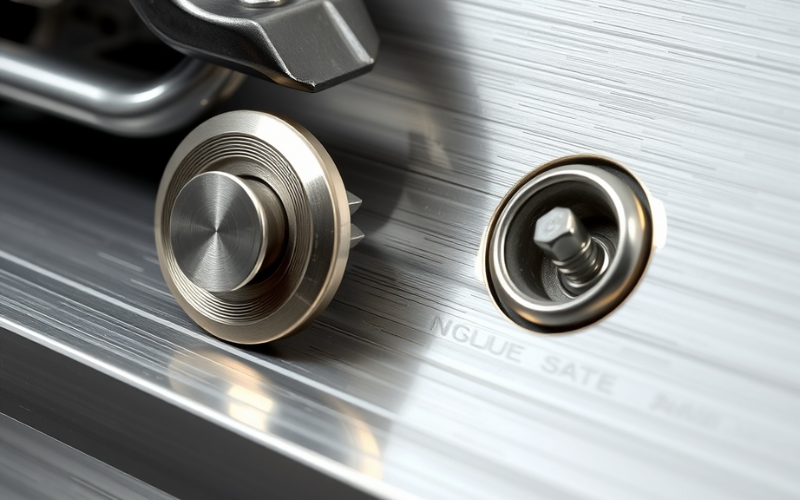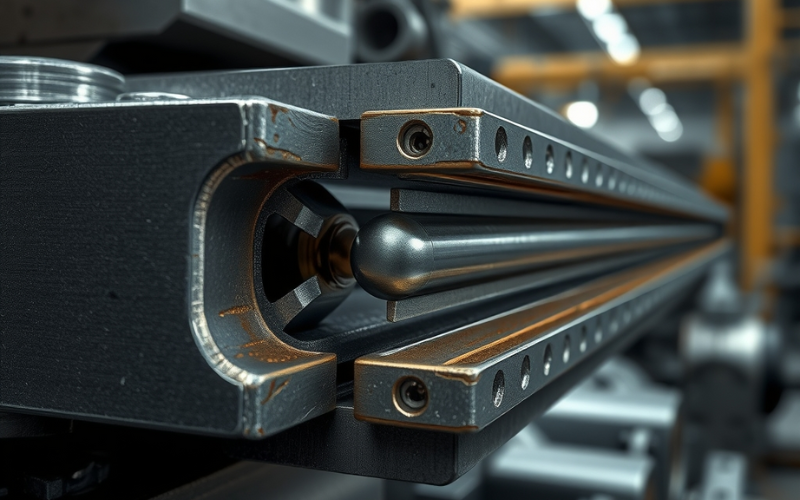Laissez Istar vous aider à démarrer votre projet avec notre expérience et notre savoir-faire !
Téléchargez vos fichiers de conception et vos exigences de production et nous vous répondrons dans les 30 minutes !

There are many different types of rivets. Picking the right rivet can be hard. This article will help you. I will tell you what I know about each type of rivet. We will look at the solid rivet, the blind rivet, and others. When you finish reading, you will know the best rivet for your job. This will help you make things that are strong and will not break for a long time. This is my guide to the wonderful world of the rivet.
Let’s start with the simple things. What is a rivet? A rivet is a mechanical fastener. It is one of the oldest ways to join things. I think of a rivet as a simple pin that is also very strong. A rivet is usually made of a head on one end and a smooth body. We call the body a shank. The idea is simple. You put the rivet through a drilled hole in two or more parts you want to connect. Then, you change the shape of the tail end of the rivet’s shank. This makes a second head. We call this new head the field head. This new head keeps all the parts together.
The rivet is a simple idea, but it works very well. A rivet is different from a screw. A rivet is a permanent fastener, which means it stays in place for good. After you put in a rivet, it is hard to take out. This makes the rivet great for things that must be strong and stay together forever. People have used rivets for thousands of years. The idea has always been a shaft with a head. The rivet is a good example of simple metal work. Each kind of rivet we talk about is a little different from this simple, strong rivet. Every rivet is used to join two or more parts.
A weld is a good way to join metal. A weld melts the pieces of metal so they become one piece. But a rivet has its own good points. A weld can sometimes break easily. A rivet is more ductile. This means it can bend a little and handle shaking better. That is why you see so many rivets on airplanes and bridges. A rivet can move just a little bit. A weld might break when it is pushed or pulled.
Another reason to pick a rivet over a weld is the material. You cannot weld all materials together. But you can often use a rivet to fasten them. For instance, you can use a rivet to join metal to plastic. You cannot do that with a weld. Also, the heat from a weld can hurt the material you are working on. Riveting is a way to join things without heat, so it does not have this problem. So, a weld is strong, but a rivet is often a better idea. The next time you think about using a weld, ask yourself if a rivet might be better. You might decide the rivet is the better choice over a weld. A rivet is a fastener you can count on.
When you go into a hardware store, you will see many different types of rivets available. It can feel like it is too much. But most rivets can be put into a few main groups. I think of them like the big families in the rivet world. If you know these groups, it is much easier to pick the right rivet. Every rivet is made for a special job.
Here are the rivets that are used most often:
These are the main groups of the rivet. There are other special rivets, too. But if you understand these, you are doing very well. Each type of rivet is made for a different kind of work. We will look more closely at each rivet. This rivet is a special kind of fastener. Every rivet is a helpful fastener.

The type of rivet is important. But the material the rivet is made from is also very important. Picking the right material for your rivet is a very big deal. You want to pick a rivet made from a material that is right for your project. If you are joining sheets of aluminum, it is a good idea to use aluminum rivets. This helps to stop rust. When different kinds of metals touch, one can make the other rust or break down. Using the same metal for your rivet stops this from happening.
Rivets are usually made from soft metals that can bend. This is because the end of the rivet must change shape to make the second head. Some common materials used for rivets are:
| Rivet Material | Bon pour | Extra Notes |
|---|---|---|
| Aluminium | Light jobs, aircraft | Fights rust, easy to change shape. |
| Acier | High-strength jobs | Strong, can be covered to fight rust. Carbon steel rivets are common. |
| Acier inoxydable | For wet places or outside | Very strong and very good at fighting rust. I often use stainless rivets. |
| Copper & Brass | For looks, for electrical jobs | Soft, easy to use. Copper rivets look nice. People make brass rivets for looks. |
Think about your job. Does it need to be very strong? Use a steel rivet or even a high-carbon steel rivet. Will it be around water? Use a stainless steel rivet. Is it important for it to be light? Use an aluminum rivet. Choosing the right material for your rivet is as important as choosing the right type of rivet. A good rivet is made from good materials. The rivets made from these different materials like steel are very strong.
Yes, it is. The solid rivet is the strongest one of all in the rivet world. When I need a connection that must not break, I use a solid rivet. This is the oldest type of rivet. You can see this rivet in old bridges, buildings, and old airplanes. A solid rivet is just what its name says: a solid piece of metal. It has a head made at the factory on one end and a solid shaft.
To install a solid rivet, you often heat it until it glows red. Then, you put it in the hole. You use a hammer or a special tool called a pneumatic gun to make the second head on the other side. When the hot solid rivet gets cool, it gets smaller. This pulls the metal sheets together with a very strong force. This makes a very tight and strong connection. Solid rivets have a great ability to hold things tight. This is why the solid rivet is a top pick for very important jobs. To use a solid rivet, you need to be able to get to both sides of the connection. The solid rivet is a simple but strong fastener.
This is the job for the blind rivet. The blind rivet is a very smart idea. I remember the first time I used a blind rivet, and it seemed like magic. A blind rivet is made for jobs where you can only get to one side of the part you are fastening. Think about putting something on a hollow pole or a box that is sealed. You cannot get inside to make a second head for a solid rivet. That is what a blind rivet is made for. The blind rivet lets you do these jobs.
A blind rivet is made of a head and a tubular body. It has a long pin, called a mandrel, that goes through it. You put the blind rivet into the hole. Then, you use a special tool, which many people call a pop rivet gun, to pull the mandrel. When the mandrel is pulled up, its head makes the end of the rivet on the “blind” side bigger. It makes a bump that works like a second head. When it is tight, the mandrel breaks off, or “pops.” This is why a blind rivet is often called a pop rivet. This type of rivet is very, very useful for all kinds of fixes and for sheet metal fabrication.
I think the blind rivet is one of the most helpful rivets for projects at home. It is quick and simple to install. The blind rivet has changed the way we fasten things in small spaces. This amazing blind rivet only needs you to get to one side. The pop rivet is a great kind of blind rivet. There are many different types of rivets, but the blind rivet is a tool that solves problems. This rivet is a real helper. Every toolbox should have a blind rivet in it.
The tubular rivet is another great fastener. It is something in between a solid rivet and a blind rivet. A tubular rivet has a shaft with a head on one end, like a solid rivet. But the other end of the shank has a hole in it, which makes it tubular. This small difference is a big deal. Because the end is hollow, the tubular rivet needs a lot less power to install than a solid rivet. You do not need to heat it. You can install a tubular rivet with a simple press or a tool you squeeze.
Tubular rivets are often used in things that do not need the huge strength of a solid rivet. Think about brakes, electronics, or even office binders. They are a great fastener that does not cost a lot of money. There are different kinds of this rivet. A semi-tubular rivet has a small hole. A full tubular rivet is hollow almost all the way to the head. The generic tubular rivet is seen a lot. The tubular rivet is easy to use. I often use a tubular rivet for work on light sheet metal. This type of rivet, the tubular rivet, is a fastener you can use for many different things.
Yes, there are. Besides the three main types, there are many special types of rivets for certain jobs. These rivets are made to fix special problems. Let me tell you about a few other different types of rivets I have used. Each rivet has a special job.

Rivets are in many places if you look for them. Using rivets is very normal in a lot of businesses. Their strength and how much you can trust them make them a fastener people choose a lot for some of the biggest and most important jobs in the world. The uses for rivets seem to go on forever.
I have seen rivets used in so many things. For example, making airplanes is a big job for rivets. Almost every airplane you see is held together by thousands of rivets. This is because a rivet can deal with the shaking when flying better than a weld can. Solid rivets and flush rivets are the most common rivet type used in airplanes. Another common job is in sheet metal fabrication. Rivets are used to join metal sheets together to make things like ducts, boxes, and the bodies of machines. A blind rivet is a very helpful tool for this work.
You will also see rivets in ships, bridges, and in your own house. The handles on your pots and pans might be held on with a rivet. Your blue jeans have copper rivets that make the pockets stronger. Even your chair at work might use a special rivet. Rivets are used a lot in things you can buy in stores. These are only a few of the common jobs. Rivets are one of the most helpful fasteners ever made. Using rivets makes things strong. Every rivet has a purpose. The rivet is a simple but very strong fastener.
So, after learning all of this, how do you pick the right rivet? You just need to ask a few simple questions. What are you connecting? How strong does it need to be? Can you reach both sides of the connection? I made a simple table to help you see which rivet type is best. This should help you choose your next rivet easily.
| Rivet Type | La force | Access Needed | Utilisation courante |
|---|---|---|---|
| Solid Rivet | Très élevé | Both Sides | Aircraft, Bridges, Heavy-duty work |
| Blind Rivet | Moyen | One Side | General fixes, Sheet metal, Cars |
| Tubular Rivet | Low to Medium | Both Sides | Electronics, Brakes, Light-duty work |
| Split Rivet | Faible | Both Sides | Leather, Wood, Soft things |
Look at your project, and then look at this table. It will help you find the right type of rivet. Do not forget to also think about the material selection for your rivet. Picking the right rivet is a very important part of doing a job well. A rivet is a simple fastener, but the right rivet can make a big difference. I hope this guide helps you with your next project that uses a rivet. A rivet is a great fastener.